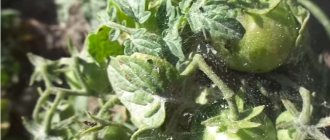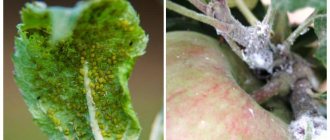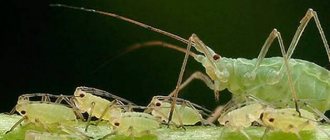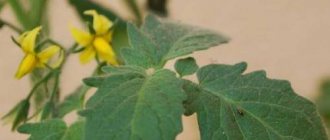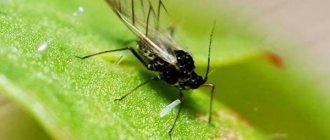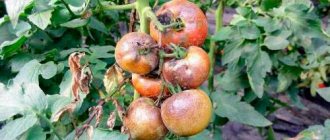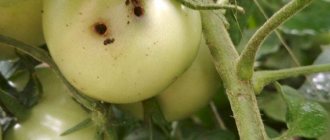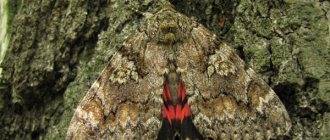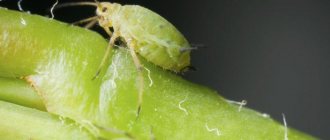You need to destroy aphids on tomatoes from the first signs of their appearance, without waiting for infection.
The insects are so small that the plants should be inspected regularly - after a quick glance, you won’t notice them. Knowing what pests look like and starting the fight immediately, you can save your crops and reap a decent harvest. Dear readers! For you, we have created communities on social networks in which useful articles and interesting ideas are published several times a day! Subscribe and receive useful content in a convenient format!
Types of aphids dangerous to tomatoes
True aphids (Aphididae) are a family of insects included in the superfamily Aphid and the suborder of the same name. The highest taxon with a different name is the order Hemiptera.
About 5 thousand species are known, of which 1,500 live in the countries of the former Soviet Union. Not all Aphididae harm tomatoes - they are not as omnivorous as, for example, the fall armyworm.
Aphids have pronounced sexual and phase polymorphism. Within one species there are several forms of individuals with different methods of reproduction, color, size and behavior.
The color of aphids can be green, gray, red, black, beige, brown. Sometimes it differs at different phases of development. Or depending on the polymorphic form. There are no species of black, red, or green aphids - this is simply a statement of the fact that such and such a representative of the Aphididae family is painted in a certain color.
All aphids have soft integuments and breathe through their abdomen. Depending on the phase of development, they may or may not have wings. They don't fly very well, but there are even migratory species.
Aphids are prolific, producing 10 or more generations per year. One founder can produce several tens of thousands of individuals per season. And this is not the limit.
Sometimes tomatoes are affected by the following types of aphids:
- Red gall apple;
- Cabbage;
- Beetroot.
But this happens infrequently, usually when the crop, which is the main nutritional base, grows next to tomatoes and has not been treated for pests. Then the aphids multiply uncontrollably, and in search of food they can spread to tomatoes.
In Russia and neighboring countries, aphids on tomatoes usually belong to one of three types: Melon, Peach, Potato. They need closer consideration.
Potato large aphid
Macrosiphum euphorbiae is a polyphagous species that feeds on different crops. Potato aphids came to Europe from North America. Now it has spread everywhere. The spread of the pest in Russia is mainly in the European part, but it also appears in other regions.
Parasitizes in greenhouses and open ground. It spreads more than 50 types of diseases, including viral ones, the control measures for which have not yet been found.
The development of potato aphids is defective - only wingless virgins and winged dispersers exist. No mating was observed. Reproduction is parthenogenetic (unisexual). This type of aphid does not have the following developmental phases:
- egg;
- founder;
- midwife (a female that gives birth to offspring of both sexes);
- males and females capable of sexual reproduction.
The wingless virgin is a large (for aphids), insect up to 4 mm long. The body is spindle-shaped. The covers are usually green, rarely red. Appears in spring.
The winged disperser is a flying insect with a length of 2.2 to 3.4 mm. The color is light green, only the paws, antennae and tips of the sucking tubes are brown. Summer individuals.
The wingless virgin hibernates. In the north - in relatively warm rooms, for example, untreated or poorly treated greenhouses. The southern regions are characterized by wintering in open ground - on weeds and plant debris.
Melon (cotton)
Aphis gossypii is called cosmopolitan in applied botany. It is widespread everywhere. It is considered one of the most harmful representatives of the superfamily.
Already in the spring, melon aphid colonies reach enormous sizes, and they feed on various crops, including tomatoes. It parasitizes plants until late autumn, sometimes even after frost.
The life cycle is the same as that of the Great Potato Aphid. Up to 20 generations develop per season. It takes 7-10 days from larva to adult.
Reproduction of wingless virgins has been recorded at -5° C. They die only if the temperature drops below -15° C. They overwinter in protected rooms and in the root zone of plants.
Wingless virgins have an ovoid body and reach a length of 1.3-2.1 mm. They can be yellow, green and black with a greenish tint. They are usually transferred from weeds to cultivated plants only after the temperature reaches 12° C.
Winged virgins appear in summer. They are usually called black aphids because of their corresponding coloration. Settlers appear in all generations. They are absolutely indiscriminate in their choice of nutritional base and enter into myrmecophily with ants of different species.
The fertility of females is about 40 larvae. All virgins - winged and wingless - are viviparous.
Peach greenhouse (tobacco)
Myzodes persicae is sometimes called the green aphid. Dioecious species. The primary host is peach. 2-3 generations appear on it. Significantly different from the previous ones, as it goes through all development cycles:
- Egg. Black, shiny. Overwinters at the base of peach buds.
- Founder. Wingless. Viviparous, asexual reproduction. Appears from an egg. The body is 2.5 cm long. The color is usually greenish-yellow, sometimes pink. The hatching period depends on the region - from February to April. Lives from 17 to 28 days. During this time (usually in April) it lays 20-60 larvae.
- Wingless virgin. Reproduces asexually. Viviparous, lays larvae. Outwardly similar to the founder. Hatches on a peach.
- Winged virgin. With the naked eye and without special knowledge, it can only be distinguished from the founder by its wings. Migrates from peach first to weeds, then to cultivated plants. The number of secondary hosts reaches 400 species.
- Wingless virgin migrants. They parasitize secondary hosts, including tomatoes. The peak of harmfulness occurs in July. Then the number of greenhouse aphids decreases and increases again by September.
- Polonoska. Winged pest. Lays larvae of females capable of sexual reproduction. Appears at the end of September on crops that are secondary hosts and migrates to peach. There it lays 25 larvae on the underside of the leaf blade.
- Normal (amphigonic) female. Oviparous. Color – from cherry to light brown, body length – 2 mm. It becomes sexually mature 13-17 days after hatching. Mates and lays 5-10 eggs at the base of the peach buds.
- Amphigonic (normal) male. Hatches at the same time as the stripers. Color – black-green, length – 1.9 mm. From the secondary host it flies to the peach to mate with females.
In warm climates, year-round heated greenhouses, a non-full-cyclic form of development is possible on indoor flowers.
In addition to damaging the soft tissues of tomatoes, greenhouse aphids are carriers of more than 100 types of diseases.
Reviews
Antonina Dmitrievna
City - Vologda
For me, aphids are a scourge. She's everywhere. Trees, bushes, roses and now tomatoes. We recommended Biotlin. I bought it because it wasn't expensive. Very satisfied, effective product. But, strangely, she still appeared. It turns out that you have to treat it 3-4 times per season; it’s a very dangerous pest.
Sergey
City — Smolensk region
I don’t understand why aphids are such a problem. It can be easily removed with a solution of laundry soap. The main thing in this matter is the multiplicity. For example, I spray everything at once every 1st and 20th. I made the solution, filled the sprayer, walked along the young shoots of the vegetable garden, and there were no problems. I recommend to everyone.
Vasily Pavlovich
Yekaterinburg city
For a long time I could not solve the problem with aphids in the greenhouse. Then I decided to leave it empty for one year, but to my surprise it did not solve the problem. I used the drug Bitlin from August. A good remedy, it helped, but by the fall it needed to be processed again, and the crop was already turning red. I had to use home remedies. I tried a lot, but simple soap was enough. I plan it and fill it with water by eye, so that the foam is stable. I process it several times, but there are much fewer insects.
Sonya
Samara city
I am a supporter of organic farming. In the fight against aphids, Fitoverm is the most effective and reliable drug. Non-toxic and natural. I spray it all over my garden, garden, and flower garden. I often run around with a spray bottle, but the insects have forgotten their way to me. I highly recommend it, especially for those who cannot tolerate chemicals.
Where do aphids come from?
Greenhouse aphids appear on tomatoes after planting in a greenhouse or open ground. It gives 2-3 generations on peach, then flies from the primary host to intermediate ones - weeds. When the temperature allows the tomatoes to be planted, it colonizes them and begins to feed on the leaves.
Potato and melon aphids do not have a primary host. The larvae can overwinter in open ground, on weeds that have not been harvested in the fall, or at the roots of plants. With the onset of warmth, winged viviparous females fly to garden crops, including tomatoes.
Species that do not have a primary host overwinter well in untreated greenhouses, even in regions with harsh climates. This is where aphids appear on tomato seedlings.
Participation of ants in the spread of aphids
Aphids can overwinter in the same nest with ants. There is even such a term - myrmecophilia. It denotes organisms (not necessarily insects) that enter into temporary or permanent association with ants.
The honeydew secreted by aphids is rich in sugars and is a delicacy for the hosts. Ants protect pests from natural enemies and move them to better plants. This is how wingless aphids end up on tomatoes and other crops.
At the end of the season, ants provide “winter quarters” for insects. They even carry eggs and females there. In anthills, aphids can withstand the most severe frost.
It is impossible to get rid of aphids on seedlings and adult tomatoes if there is an anthill nearby. They also need to be destroyed. Otherwise, after some time a new colony will appear on the treated plants.
Tips and tricks
- Promptly remove fallen leaves, tops and weeds into the compost pit. This will make the area unattractive for overwintering pests.
- By winter, the compost pit is covered with a layer of earth to prevent insects from getting out.
- Aphids do not tolerate low temperatures, so after a warm winter their population and activity especially increase.
- If pests have attacked cucumbers, then next season you should not plant tomatoes in the same place.
Aphids can cause serious damage to the tomato crop. Insects multiply rapidly, so measures should be taken immediately after detecting pests. The best option would be a combination of several control methods.
How do aphids harm tomatoes?
If aphids appear on tomatoes, they need to be removed as soon as possible. Insects cause enormous harm to crops:
- Aphids pierce leaves, stems of tomatoes, during flowering - buds, and suck out cell sap. This in itself leads to depletion of plants, slower development, and premature leaf fall. Bushes infested with aphids will bloom poorly. The yield of affected tomatoes is reduced.
- As a result of their vital activity, aphids secrete honeydew. This attracts other pests and is a breeding ground for many diseases. For example, sooty fungus, which would hardly appear on tomatoes if the leaves of the crop were not covered with honeydew.
- It is common for aphids to form large colonies. If nothing is done, they will completely cover the young vegetative organs. And this already interferes with photosynthesis.
- Aphids are carriers of dangerous tomato diseases, including viral ones, from which it is impossible to save plants.
Symptoms
Novice gardeners may not recognize aphid damage in tomato beds in time. The pest consumes sap from the top of the shoots, weakens them, resulting in greatly reduced growth. Tomatoes wither and yield decreases. By carefully inspecting garden crops, you can notice warning signs of pest infestation:
- clusters of small black and white dots are visible on the stems and leaves;
- droplets of sweet liquid appear on the leaf blades;
- seedling growth slows down, some leaves become deformed or look limp.
A sooty fungus often develops on the sticky secretions of aphids - a black coating appears. It can be easily removed with a damp sponge. Small lesions merge into solid dark spots. Having noticed signs of infestation, it is important to know how to treat aphids on tomatoes at home.
How to identify a pest
What a tomato affected by aphids looks like can be clearly seen in the photo. Insects usually live in colonies, especially wingless virgins that cannot fly, which are “herded” by ants. They completely adhere to the top of the tomato and the adjacent young vegetative organs.
Winged females can settle on the underside of leaves. With severe damage, the lower part of the plate is completely covered with green or black pests.
Other signs of aphid infestation of tomatoes:
- vegetative organs are covered with sticky sweet honeydew;
- leaves curl, flowers are deformed, buds do not open;
- tomatoes look depressed;
- with severe damage, the aphid drinks all the juice from the vegetative organs, and they dry out.
The pest does not touch already set fruits. He simply cannot bite through the thick skin.
Reasons for appearance
Important! Tomatoes are grown using seeds or purchased ready-made seedlings. In the first case, aphids can hide in the ground and become active in a favorable environment. In the second case, individuals may already be on the back side of the leaves.
When purchasing young plants, it is important to carefully examine the leaf blade.
Favorable conditions for the development and reproduction of the pest are as follows:
- a warm, dry room without drafts, but well ventilated;
- temperature from +25 to +30°C.
Aphids in stuffy and warm rooms can move to indoor flowers and other garden seedlings. Often individuals were spotted on verandas and balconies. They ate almost all ornamental plants.
How to fight aphids on tomatoes
How to deal with black aphids on tomatoes depends on the degree of infestation of the crop. The earlier the problem is detected, the more gentle methods can be used.
The spread of aphids is prevented by too low and high temperatures, drought, and frequent rains.
Chemicals
Treatment of tomatoes against aphids is possible with insecticides:
- pyrethroids;
- neonicotinoids;
- organophosphorus compounds.
There are a lot of preparations; gardeners can choose them at their discretion and use them strictly according to the instructions. You need to spray tomatoes early in the morning or in the afternoon.
But chemicals cannot always kill aphids. Causes:
- The pest quickly develops resistance to chemicals. You can kill aphids with the same thing 1-2 times, then you need to change them.
- Pyrethroids, upon contact with an alkaline environment, turn from an effective agent into a useless one. Not even all experienced gardeners know about this. To spray the tomatoes, they use a solution of laundry soap as an adhesive. But it’s better to add whey to the bottle.
Biological products
As practice has shown, when choosing how to treat tomatoes against aphids, it is better to turn to biological products.
They help remove pests more effectively than chemical ones, and they also have a number of other advantages:
- Aphids do not get used to preparations of biological origin;
- using them at home is safe for bees and humans;
- The waiting period is minimal; after 2-3 days you can tear the tomatoes, wash them and eat them.
It is recommended to pay attention to the following biological products:
- Bitobaxicillin;
- Actotsid (Aktofit);
- Fitoverm;
- Entobacterin (waiting period – 5 days);
- Arrow.
All of them are not recommended for use in tank mixtures together with preparations of chemical origin, including foliar fertilizers.
Folk remedies
Not all gardeners accept the use of chemicals. You can fight aphids with folk remedies only in the initial stages and weak spread of the pest.
Treatment with regular soap helps a lot. Aphids breathe through their abdomen; if a solution gets on it, a film forms. The insect will not be able to breathe and will die. Various oils also work.
Treating tomatoes with dry mustard infusion gives excellent results:
- Powder (100 g) is dissolved in 1 liter of cold water.
- Insist for 5 days.
- Dilute with water to 10 l.
- Strain.
- Tomatoes are processed.
For greater efficiency when preparing the concentrate, you can add ash at the same time as mustard. Soap is used as an adhesive - it itself fights pests well.
Among plants, it is recommended to use dandelion as a remedy for aphids on tomatoes. A liter jar of raw materials is filled with 5 liters of water and boiled for 5-7 minutes. Leave to cool naturally. Top up to 5 liters and process the tomatoes. You can use the whole dandelion - leaves, flowers, roots, stems.
Ineffective methods
Some gardeners, having noticed that black aphids have appeared on tomatoes, do not know how to deal with them correctly, and use ammonia. For the pest, ammonia creates discomfort, nothing more. Flying individuals may leave the tomatoes for a while. When the smell dissipates, they will return to their native place - the damaged leaves and stems have already lost their turgor, they are easier to pierce.
Garlic and other plants with a strong smell also work. They nuisance the aphids rather than kill them. As soon as the aroma becomes weaker, the pest will return.
The use of strong-smelling infusions will only be effective on an ongoing basis. And not as a method of control, but to prevent aphids from entering the garden bed. If the pest has already started eating tomatoes, you cannot drive it away - you can only kill it.
Cola contains phosphoric acid, which can kill aphids. But the sugar contained in the drink will attract other pests and serve as a breeding ground for pathogens.
Chamomile treatment is not effective at all. Pyrethroid preparations are not prepared based on it, but from a completely different plant.
Prevention measures
To reduce the likelihood of infestation with black aphids or other varieties, preventive measures are necessary.
- Pay attention to large concentrations of garden ants in your garden or vegetable garden. Their anthills may contain aphid eggs. To effectively combat these pests, it is recommended to first remove the ants from your area.
- Even in the early stages of infection, take comprehensive measures. A female can lay more than 2 thousand eggs in a month, which leads to rapid proliferation of the colony. Even at the initial stage of infection, it is better to use several control methods.
- Plant repellent plants and attract ladybugs to your area.
Recipe based on tomato leaves
As noted, tomatoes, as members of the nightshade family, contain toxic compounds called alkaloids in the fruit and leaves. When tomato leaves are crushed, they release these substances, which when diluted with water become even more toxic to insects. In addition, the liquid form of the solution allows for more effective spraying treatment.
To prepare this solution, you simply need to soak one to two cups of chopped tomato leaves in two cups of water. If possible, you can chop ripe fruits there, but you should not use tomatoes bought in the store for these purposes - they must be fresh. The mixture is infused for 24 hours. After this, the “porridge” needs to be strained through cheesecloth and added 300-500 ml of water.
What harm does the insect cause?
The parasite is also dangerous because it transmits viral and fungal diseases. Infection occurs through the proboscis, with which the insect sucks out the juice. The pest carries diseases such as tomato mosaic, late blight, and powdery mildew.
As the colony grows, the leaves of the plant become deformed and dry out. If the tomatoes are already ripe, aphids will not cause them any harm. If not, the fruits stop growing and take on an irregular shape because they lack nutrition.
It must be said right away that the damage is very serious. The pest can suck juice not only from leaves or stems, but also from buds, as well as from flower buds. The affected plant's growth is greatly reduced. The fruits may not fully ripen. Please note that if the bush is damaged, it is not able to withstand weather changes or the influence of other factors. His immunity is sharply reduced.
Thanks to aphids, black sooty mildew (fungal infection) appears on plants, and galls grow, which make the greens even weaker. In addition, these insects attract hordes of ants that feed on honeydew. The latter is a very good environment for fungal infection.
Garlic recipe
Seasoned gardeners have long relied on garlic as an integral part of pest control. Garlic contains sulfur, which, in addition to being toxic to insects, also has antibacterial and antifungal properties. The soap solution in this mixture also destroys the bodies of soft-bodied pests.
To prepare the garlic remedy, you should mince or finely chop three or four cloves of garlic and add two teaspoons of vegetable oil to them. Let this mixture sit for 24 hours. Then you need to strain it from the solid parts and add half a liter of water and one teaspoon of liquid dishwashing detergent. This mixture can be stored and diluted as needed. Before spraying, dilute two tablespoons of the mixture in a glass of water.
Garlic oil is a fairly active caustic substance, so you should not spray all the seedlings at once. If after treatment, after a couple of days, there are no signs of damage on several of the weakest bushes, and there are fewer aphids, then you can continue treatment on the rest of the seedlings.
These homemade recipes are easy to use, inexpensive and very effective. In most cases of aphids, they are able to completely replace any chemicals that can have a toxic effect against humans. We wish you a bountiful and healthy harvest!
The best products for greenhouses
If appropriate measures are not taken, aphids in greenhouses can multiply as rapidly as in open ground.
It is necessary to create conditions that are uncomfortable for aphids:
- the temperature in the greenhouse should be 22-24 degrees, and the humidity should not be lower than 85%;
- regularly remove dead plant branches and ventilate the greenhouse;
- in winter, disinfect the greenhouse with bleach or caustic soda.
If aphids are present, all methods recommended for open ground can be applied to them. Biological agents that work effectively include introducing ladybugs into a greenhouse and fumigating them with tobacco smoke with the doors tightly closed. Among the chemicals, the most popular in greenhouses are Fitoverm, Entobacterin, and Biotlin.
For open ground
The use of outdoor products directly depends on the proliferation of pests. Gardeners should always be on guard: aphids are not particularly picky about where they settle.
If one year she is indifferent to tomatoes, then the next she can settle there. According to gardeners and gardeners, soap solution and ash are recognized as the best folk remedies. Among the chemicals - green soap, Inta-Vir, Fitoverm, the drug Oberon, used at the initial stage of aphid infestation.
Mistakes of beginner gardeners
Inexperienced gardeners often do not pay attention to signals that there are aphids in the area, and therefore precious time for a quick response is lost, and the pests make their home in the garden.
Signs that precede an aphid invasion:
- Ant activity. Ants are friends of aphids, so if you notice the movement of ants in the beds, it means that aphids will soon appear on the seedlings. What to do? Fight ants.
- Several pests on the branches. This is a signal that they will attract hordes of aphids in a short period of time. Immediately start spraying the plants with what you have at hand: soap solution or ash.
- Rarely weeding the beds. Frequent loosening of the soil is the key to good air circulation between tomato bushes, which is beneficial for plant health. If you grow crops in greenhouses, do not forget to ventilate them more often.
Inspection of plants should be done several times a week, looking under the leaves of the plantings, because this is a favorite breeding place for aphids. The faster you react and apply one of the methods described above, the more effective the measures to destroy aphids will be.
